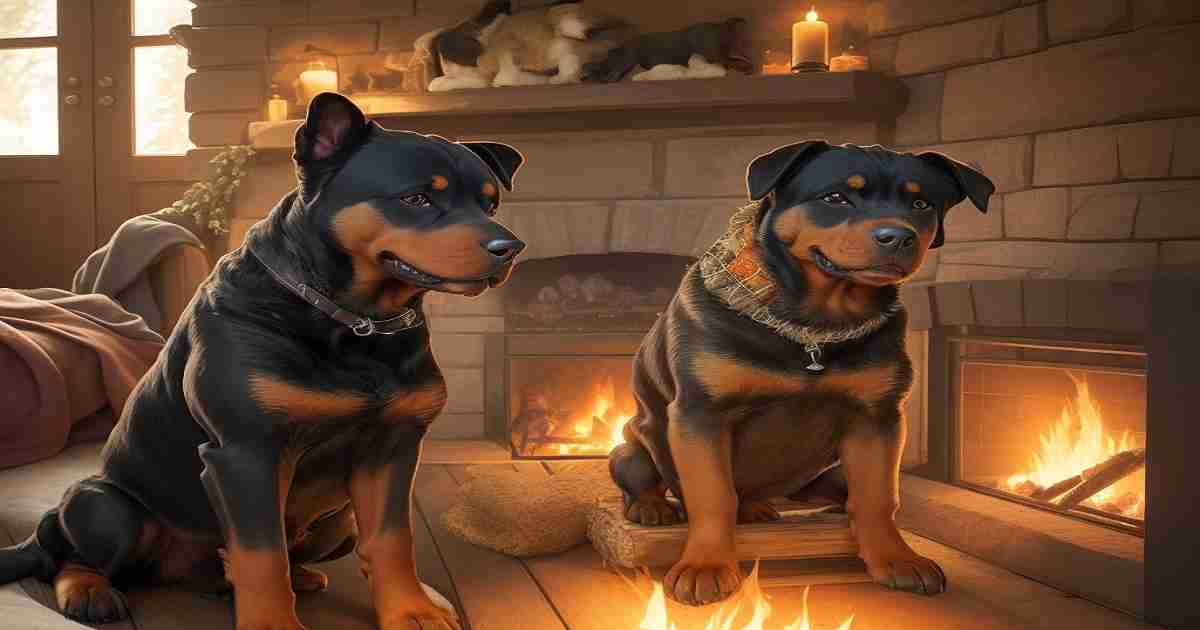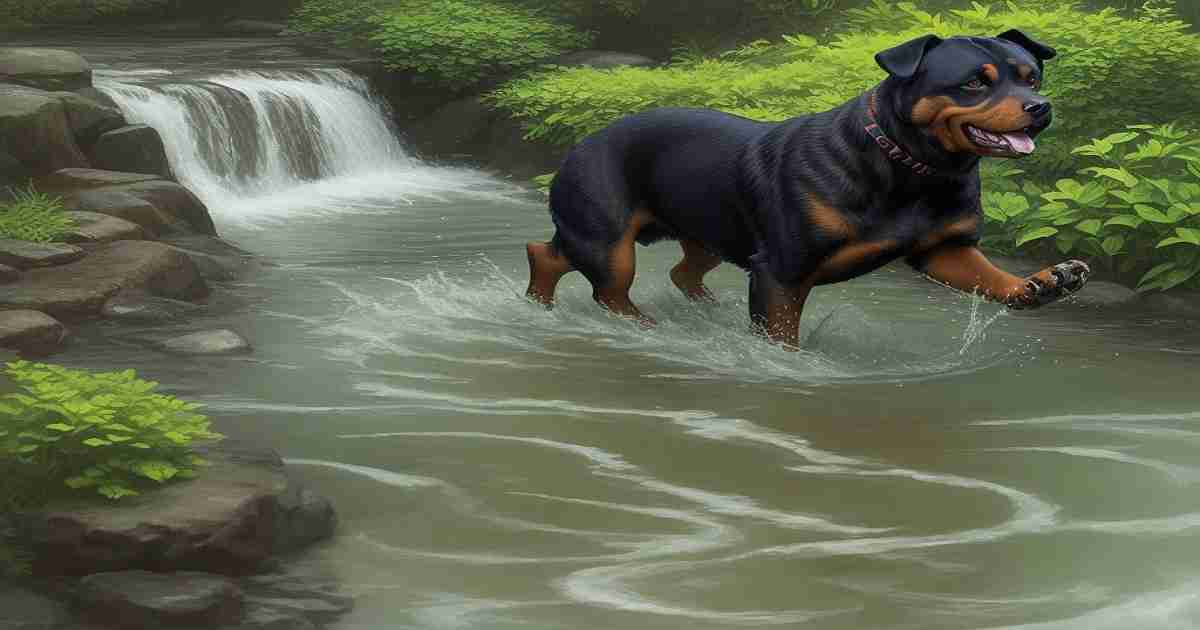Rottweilers are robust, active dogs originally bred to herd cattle over extensive distances.
All that running and herding built up a lot of body heat! As a result, this breed evolved a tendency to pant frequently as their primary cooling mechanism.
But do Rottweilers pant more than the average dog breed? How can you determine if your loyal companion’s panting is within the range of normal or a cause for concern?
This comprehensive guide examines the question “Do Rottweilers pant a lot?” by exploring:
• The respiratory anatomy behind Rottweiler panting
• Typical triggers that induce heavy panting episodes
• Warning signs indicating problematic excessive panting
• Prevention strategies to avoid overheating
• Useful training techniques to minimize anxious panting
• Key differences between puppy and adult Rottweiler breathing patterns
Armed with science-backed insights on what’s normal for your Rottweiler’s respiration, you can optimize their health and remain vigilant about any abnormal breathing that warrants veterinary attention. Let’s get started!
Do Rottweilers Pant a Lot? The Science Behind Their Respiration
To understand why Rottweilers frequently pant to a moderate or heavy degree, we first need to examine their respiratory anatomy and how it facilitates panting as a cooling mechanism.
What is panting from a physiological perspective?
Panting refers to rapid, open-mouthed breathing characterized by quick, shallow inhalations and exhalations.
Unlike normal breathing, which utilizes the lungs to oxygenate the body, panting primarily evaporates moisture from the mouth and tongue to dissipate heat.
When a Rottweiler starts panting heavily, here is what happens:
1. Air is drawn rapidly through the open mouth over the elongated soft palate.
2. It passes over the saliva-coated surfaces of the tongue and inner cheeks.
3. As it moves, moisture evaporates from these surfaces, lowering the blood temperature underneath.
4. This cooled blood circulates through the body, releasing heat from the skin and lowering the dog’s core temperature.
5. The respiratory center in the brain controls panting. When the hypothalamus senses rising body heat, it triggers rapid, shallow breathing.
Certain physical adaptations make dogs extremely efficient panting machines compared to humans:
• Their long respiratory tract and wide bronchioles allow large volumes of air to pass through with minimal resistance or effort.
• The extensive surface area of tissues in the mouth and nasal cavity provides ample evaporation potential.
• As panting commences, the tongue hangs out to maximize moisture dissipation.
• Powerful contractions of the diaphragm enable rapid inhalation.
Do Rottweilers pant more than the average dog?
Their thick double-coat makes them prone to overheating quickly. For Rottweilers, panting provides an indispensable means of evaporative cooling to maintain a safe body temperature.
What Triggers Lead to Rottweilers Panting Heavily?
Now that we’ve covered the science behind why panting is essential for Rottweilers, what are the most common triggers for episodes of heavy rapid breathing in this breed?
Physical Exertion or Exercise
Vigorous exercise causes all dogs to build up heat through muscle exertion.
Do Rottweilers often pant after intense running, hiking, or play sessions?
Absolutely! For this athletic breed, physical activity readily induces heavy panting to prevent overheating and hyperthermia.
Do Rottweilers pant a lot even after mild exercise on a hot day?
Yes, their heat-sensitive build means even light activity can trigger extensive panting. Always monitor your dog’s respiration after exercise.
Hot or Humid Environments
Do Rottweilers pant a lot in summer? You bet! With their dense insulating double coat, Rottweilers rapidly overheat when ambient temperatures exceed 80°F. Intense panting enables necessary evaporative cooling.
Humidity also impairs evaporation, so moist, muggy weather makes it even harder for Rottweilers to stay cool, leading to prolonged heavy panting. Provide ample shade and water.
Stress, Anxiety, or Excitement
In acutely stressful situations like vet visits, thunderstorms, or entering unfamiliar environments, a Rottweiler’s automatic response is to pant rapidly to deliver more oxygen to the brain and body.
This physiological reaction helps calm them down by increasing alertness and oxygenation.
Nervous, highly excitable Rottweilers may pant more chronically whenever their surroundings trigger unease or overstimulation. Anxiety-related panting warrants training.
Discomfort or Pain
Dogs experiencing post-injury/surgical pain or discomfort from conditions like bloat will often pant extensively as increased respiration provides physical and emotional relief.
Diagnose and treat the underlying cause of discomfort to manage pain-related panting episodes.
The majority of routine Rottweiler panting arises from one of these common motivations.
However, uncontrolled chronic heavy panting or panting combined with worrying symptoms warrants medical oversight.
Warning Signs: Is My Rottweiler’s Panting Excessive?
While most Rottweiler panting is normal, excessive uncontrolled respiration or panting paired with concerning symptoms can signal an underlying illness requiring prompt veterinary care.
Red flag warning signs include:
• Unrelenting heavy panting, even at rest or without normal triggers
• Panting without pause for extended periods
• Panting accompanied by vomiting, diarrhea, loss of coordination, or collapse
• Audible wheezing, coughing, or gagging sounds alongside panting
• Labored breathing with exaggerated abdominal effort
• Bluetongue or gums indicating oxygen deprivation
• Weakness, lethargy, and inability to settle
Never ignore changes in your Rottweiler’s typical panting rhythms, especially when combined with worrying symptoms.
Schedule a veterinary visit right away for assessment. Timely treatment of underlying illness is critical.
Preventing Rottweilers From Panting Excessively
While Rottweilers are more prone to being “pantie” than some breeds, there are ways you can proactively minimize situations triggering heavy breathing episodes:
• Ensure unlimited access to fresh water, both indoors and outside.
• Provide ample shade and ventilation in all areas your dog frequents.
• Use cooling mats, vests, and fans to regulate temperature on hot days.
• Limit intense exercise during peak heat and humidity. Opt for indoor play.
• Maintain a healthy weight – excess pounds exacerbate heat intolerance.
• Administer veterinary-prescribed anxiety medication if your dog excessively pants from chronic stress or noise phobia.
• Avoid overexertion and enforce rest after vigorous exercise or play sessions.
You can reduce scenarios causing your Rottweiler undue discomfort and heavy panting with diligent preventative measures.
But some individuals simply have lower innate respiratory stamina based on health, age, and other variables.
Do Rottweiler Puppies or Adults Pant More?
There are some natural variations in respiratory patterns and panting tendencies based on a Rottweiler’s age and life stage:
Rottweiler Puppy Panting
As youngsters with lower body mass and higher metabolism, Rottweiler puppies generate and absorb heat rapidly.
It’s common for puppies to pant extensively, even after mild exercise or play. Everything is new and exciting to a puppy brain, so anxiety and arousal trigger frequent panting episodes.
Since puppies tire easily, diligently monitor their respiration when active to avoid overheating or overexertion.
Adult Rottweiler Panting
While adult Rottweilers pant heavily when hot or active, excessive uncontrolled panting can signal an underlying illness, laryngeal paralysis, hypothyroidism, heart disease, and other chronic conditions may first be noticeable in mature dogs through respiratory changes like fast, labored panting.
Ensure your adult Rottweiler receives adequate daily exercise to maintain cardiovascular conditioning and healthy respiration. Closely track any deviation from baseline panting patterns in an adult dog.
Both puppies and adults require vigilance, but the underlying drivers and veterinary approach to assessing and managing excessive panting differ between life stages.
Training Strategies to Reduce Anxious Panting in Rottweilers
In addition to prevention, active training can help minimize worry-based panting in Rottweilers prone to anxiety:
• Use positive reinforcement to reward calm, settled behavior, not anxious panting. Ignore or temporarily move away from stressed panting.
• Teach a “settle” cue to interrupt obsessive panting episodes using high-value treats.
• Systematically counter condition panting triggers like car rides or vet visits by pairing them with a favored reward to build positive associations.
• Socialize your Rottweiler extensively from puppyhood to increase confidence.
• Maintain rigorous exercise to increase fitness and decrease restless energy that may manifest as panting.
• Speak to your veterinarian about prescription anti-anxiety or calming supplements in chronic cases.
Conclusion
In summary, Rottweilers tend to pant as a mechanism for thermoregulation and physiological coping.
Their large size, dense coat, and high activity need to predispose them to need evaporative cooling via panting on warm days or after strenuous exercise.
However, abnormal or excessive panting can also indicate potential health concerns.
As a dedicated Rottweiler owner, routinely observing your dog’s normal panting behavior provides a baseline to recognize problematic changes.
Remember your companion’s triggers, communication style, and medical predispositions when assessing panting episodes.
With keen observation and proactive prevention, you can keep your dog’s respiration within a healthy range.
Remember, acute or chronic heavy panting warrants veterinary examination to diagnose and treat any underlying issues.
Never hesitate to consult your vet if your Rottweiler displays signs of respiratory distress, overheating, pain, or non-remitting panting unaligned to environmental triggers. Timely intervention can prevent the worsening of serious medical conditions.
With diligent monitoring and prompt response as needed, you can ensure your beloved Rottweiler’s panting remains a normal physiological response, not a cause for alarm. Here’s to many happy, healthy years of adventures together ahead!
FAQs
How much panting is too much in Rottweilers?
- Frequent low to moderate panting when hot or active is expected. However, nearly nonstop uncontrolled heavy open-mouthed breathing, even when resting comfortably or without clear triggers, can indicate a health problem requiring veterinary assessment.
Is it normal for my Rottweiler to pant heavily after exercise?
- Yes, panting after strenuous physical exertion is a normal response as your dog regulates their body temperature back down. Provide access to shade, mist with water, and monitor for a return to a normal respiratory rate within 10-15 minutes of activity stopping.
Could my Rottweiler’s chronic heavy panting indicate pain?
- Yes, dogs in pain from an injury, post-surgery, or due to an illness like bloat will frequently exhibit uncontrolled heavy panting. Look for pants with behavioral changes like reduced activity, odd postures, whining, or uncharacteristic aggression. Promptly notify your vet.
What temperature is dangerously hot for Rottweilers?
- With their double coat, temperatures above 80°F start posing a high risk for heat stroke in Rottweilers. Limit exercise, provide shade, mist with water, and bring them indoors to air conditioning if you see signs of overheating, like heavy open-mouth panting and a deep red tongue.
Why does my Rottweiler pant heavily in the car?
- Anxiety from travel can induce drooling and rapid stress panting. Use treats and happy tones to reinforce calmness in the car positively. Keep the a/c on, take regular breaks on long trips, and ask your vet about anti-anxiety supplements if car sickness is chronic.
- Closely observing your Rottweiler’s panting rhythms provides insight into their health and well-being. Consistent excessive respiratory distress signals an underlying issue requiring veterinary diagnosis and treatment.
The Takeaway: Is Your Rottweiler’s Panting Normal?
- To summarize, as an active muscular breed prone to overheating, Rottweilers tend to pant heavily, especially when excited, anxious, or trying to cool down. However, runaway chronic panting or any breathing changes combined with concerning symptoms warrants medical investigation.









